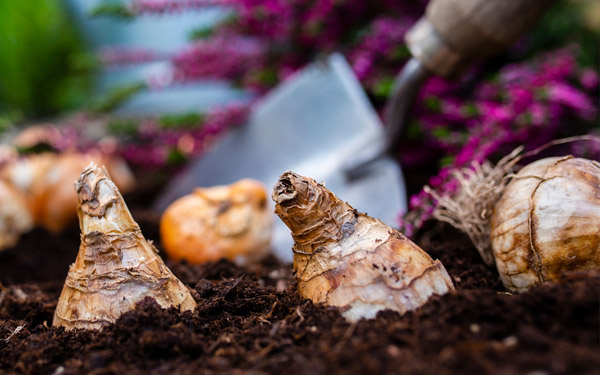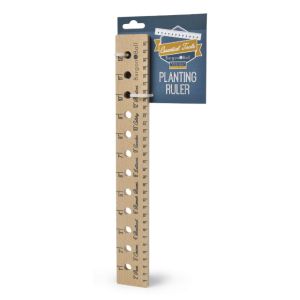Bulb Advice
Flowering bulbs are a wonderful way to add a splash of colour to your garden. They work brilliantly in small spaces, large beds or even hanging baskets. You can grow them in containers on balconies or fill up your window box. There's a huge variety of bulbs out there and, with proper planning, can be growing and flowering throughout the whole year so you never have to be without those beautiful colours.
Bulbs are...
- Easy to grow
- Planted in spring, summer & autumn
- Low maintenance
- Suitible for all growing conditions
- In flower all year round
- Usually quite hardy
- In full bloom in spring
- Able to grow in small or large spaces
What Are Bulbs?
'Bulb' is a generic term for true bulbs, corm, tuber, tuberous root, and rhizome. They are all basically like food storage for plants, keeping all the nutrients for growth stored away safely inside ready to bloom again when given the chance!
Some of the easiest and most popular bulbs for budding gardeners are daffodils, tulips & alliums. The cheapest option usually is to buy as dormant bulbs, but you can buy growing in pots for a boost and instant flash of colour!
Ready to Plant?
Planting times vary depending on when the bulb will flower. With a little bit of planning, you can have your bulbs flowering all year round: Alliums, Daffodils & Hyacinths in Spring, Dahlia, Gladiolus & Begonias in Summer, Cyclamen, Lilies & Crocus in Autumn. In warm winters you can even bloom Narcissus & Snowdrops. Check out our Garden Advice Pages to find out more.
The planting process is rather easy; dig in plenty of compost, make sure you're planting at the correct depth for your bulb, and done!
Maintenance
Generally bulbs are fairly low maintenance. They will need plenty of water, especially in the summer months. Once shoots start to appear, you can feed your bulbs every seven to ten days with a high-potassium fertiliser such as a liquid tomato feed. This helps to promote great flowering next year. It's important to deadhead your bulbs. Cut off spent flowers and the base of the stalk, this prevents the plant from wasting its energy on making seeds, reserving more for next year's bloom.
Common Issues
Your bulb should be fairly free from problems. Make sure you plant them at the correct depth, as otherwise they may fail to flower in years to come.
Damaged and diseased bulbs will need to be discarded, as well as those with yellow mottled foliage as you don't want anything to spread to your healthy plants.
There are some pests that target bulbs like aphids, slugs, snails & squirrels. Keep an eye out for these critters and react accordingly.
Planting
Planting times for bulbs vary depending on when they flower. Generally it's: spring-flowering plants in autumn, summer-flowering plants in Spring, autumn-flowering plants by late summer & a couple of special cases in winter.
It's important to plant your bulbs at the correct depth, with enough space & with the right amount of sunlight.
If you have light or sandy soil, dig in lots of compost and improve drainage with some leaf mould, well-rotten manure or garden compost. We suggest 5-10kg per square metre as a rule of thumb.
As long as they've got the sun & the drainage, you can bulbs all over the place! Consider naturalising your lawn with some bulbs for the wild meadow look.
Check out our planting guide above for what & where to plant this month. You can also see what will be in flower this month for a bit of inspiration.
Maintenance
Watering
Your bulbs will need plenty of water while they grow. Keep watering after they flower for about 6 weeks, the leaves will then die down and the bulb will become dormant, don't forget to give your summer-flowering bulbs some extra water during dry spells.
Make sure your bulbs in containers don't dry out. Water them thoroughly until the compost is moist but not soggy.
Feeding
Feeding your bulbs with high-potassium fertiliser every 7-10 days will promote great flowering next year too. Start to feed them when the shoots appear, and stop as the leaves die down later in the season.
Vigorous summer-flowering tubers & rhizomes will benefit from a high-potash liquid feed every 2 weeks during flowering.
Deadheading
Cut off the dead flowers at the base of the stalk. Unlike with lots of plants, for true bulbs and corms, this doesn't stimulate further flower growth, but it is important as it stops the plant from wasting energy on making seeds. We want the plant to put as much goodness as possible back into the bulb ready for next year. With rhizomes, you will see further flowering as a result of deadheading.
For true bulbs & corms, keep watering and fertilising until the dead leaves are yellow and straw-like, about 6 weeks after flowering. This ensures you give the plant plenty of time to send food back into the bulb.
Overwintering & Lifting
Hardy bulbs will be fine in the ground all year. Bulbs in containers will generally be ok too, if you have an unheated indoor space then that can be safer.
For less hardy plants it's best to put them in containers, if they weren't already, and bring them inside. Another option is to cover the areas where they are planted with some insulating mulch to keep them slightly warmer. It's important to also have free-draining soil in this instance as overly wet soil throughout the winter will cause the bulbs to rot.
Tulips perfer to be kept dry when dormant, so they will need to be lifted, dried & stored ready for next autumn.
To Lift & Store
- Once the foliage has died down, carefully dig and remove loose soil from the bulbs
- Trim off the roots and outer layers of loose tunic
- Discard damaged or diseased bulbs, they are unlikely to perform the following year
- Dry the bulbs on a tray for at least 24 hours, this helps prevent fungal rots in storage
- Put the bulbs in paper bags or nets and store in a cool, dry place ready for next year!













